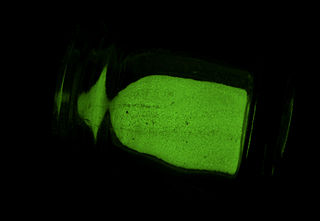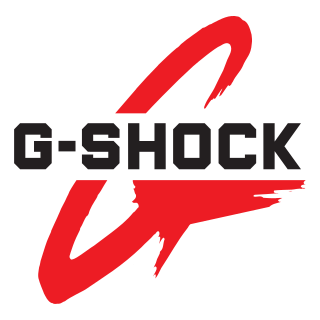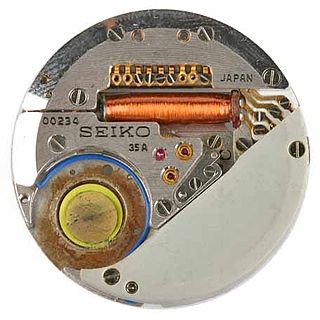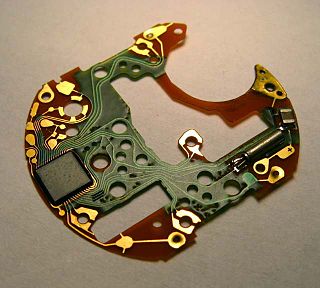
Electroluminescence (EL) is an optical and electrical phenomenon, in which a material emits light in response to the passage of an electric current or to a strong electric field. This is distinct from black body light emission resulting from heat (incandescence), chemical reactions (chemiluminescence), reactions in a liquid (electrochemiluminescence), sound (sonoluminescence), or other mechanical action (mechanoluminescence), or organic electroluminescence.

A watch is a portable timepiece intended to be carried or worn by a person. It is designed to keep a consistent movement despite the motions caused by the person's activities. A wristwatch is designed to be worn around the wrist, attached by a watch strap or other type of bracelet, including metal bands, leather straps, or any other kind of bracelet. A pocket watch is designed for a person to carry in a pocket, often attached to a chain.

A phosphor is a substance that exhibits the phenomenon of luminescence; it emits light when exposed to some type of radiant energy. The term is used both for fluorescent or phosphorescent substances which glow on exposure to ultraviolet or visible light, and cathodoluminescent substances which glow when struck by an electron beam in a cathode-ray tube.

Casio Computer Co., Ltd. is a Japanese multinational electronics manufacturing corporation headquartered in Shibuya, Tokyo, Japan. Its products include calculators, mobile phones, digital cameras, electronic musical instruments, and analogue and digital watches. It was founded in 1946, and in 1957 introduced the first entirely compact electronic calculator. It was an early digital camera innovator, and during the 1980s and 1990s, the company developed numerous affordable home electronic keyboards for musicians along with introducing the first mass-produced digital watches.
Timex Group USA, Inc. is an American global watch manufacturing company founded in 1854 as the Waterbury Clock Company in Waterbury, Connecticut. In 1944, the company became insolvent but was reformed into Timex Corporation. In 2008, the company was acquired by Timex Group B.V. and was renamed Timex Group USA.

Seiko Group Corporation, commonly known as Seiko, is a Japanese maker of watches, clocks, electronic devices, semiconductors, jewelry, and optical products. Founded in 1881 by Kintarō Hattori in Tokyo, Seiko introduced the world's first commercial quartz wristwatch in 1969.
Bulova is an American timepiece manufacturing company that was founded in 1875 and has been owned by Japanese multinational conglomerate Citizen Watch Co. since 2008. The company makes watches, clocks and accessories, and it is based in New York City.

Swatch is a Swiss watchmaker founded in 1983 by Ernst Thomke, Elmar Mock, and Jacques Müller. It is a subsidiary of The Swatch Group. The Swatch product line was developed as a response to the "quartz crisis" of the 1970s and 1980s, in which inexpensive, battery-powered, quartz-regulated watches were competing against more established European watchmakers focused on artisanal craftsmanship producing mostly mechanical watches.

The G-Shock is a line of watches manufactured by the Japanese electronics company Casio, designed to resist mechanical stress, shock and vibration. G-Shock is an abbreviation for Gravitational Shock. The watches in the G-Shock line are designed primarily for sports, military and outdoors-oriented activities; all G-Shocks have a chronograph feature, 200 metre water resistance and an alarm, with either a digital display, analogue display or a combination of analogue and digital displays. Other features such as a countdown timer, world clock, and a backlight are included in most models. Newer high-end models in the line also feature GPS, directional, pressure and temperature sensors, radio-controlled time adjustment and Bluetooth time adjustment achieved by connecting the watch to a smartphone via a dedicated application.

Eco-Drive is a model range of watches manufactured and marketed worldwide by Citizen Watch Co., Ltd., powered primarily by light. As of 2007, the company estimated the drive system had eliminated the disposal of ten million batteries in North America.

Citizen Watch Co., Ltd. is an electronics company primarily known for its watches and is the core company of a Japanese global corporate group based in Nishitokyo, Tokyo, Japan. In addition to Citizen brand watches, it is the parent of American watch company Bulova, and is also known for manufacturing small electronic devices such as calculators. Beyond watches and electronics, Citizen also manufactures precision CNC machining equipment.

Electroluminescent Displays (ELDs) are a type of flat panel display created by sandwiching a layer of electroluminescent material such as Gallium arsenide between two layers of conductors. When current flows, the layer of material emits radiation in the form of visible light. Electroluminescence (EL) is an optical and electrical phenomenon where a material emits light in response to an electric current passed through it, or to a strong electric field. The term "electroluminescent display" describes displays that use neither LED nor OLED devices, that instead use traditional electroluminescent materials. Beneq is the only manufacturer of TFEL and TAESL displays, which are branded as LUMINEQ Displays. The structure of a TFEL is similar to that of a passive matrix LCD or OLED display, and TAESL displays are essentially transparent TEFL displays with transparent electrodes. TAESL displays can have a transparency of 80%. Both TEFL and TAESL displays use chip-on-glass technology, which mounts the display driver IC directly on one of the edges of the display. TAESL displays can be embedded onto glass sheets. Unlike LCDs, TFELs are much more rugged and can operate at temperatures from −60 to 105 °C and unlike OLEDs, TFELs can operate for 100,000 hours without considerable burn-in, retaining about 85% of their initial brightness. The electroluminescent material is deposited using atomic layer deposition, which is a process that deposits one 1-atom thick layer at a time.

The quartz crisis (Swiss) or quartz revolution was the advancement in the watchmaking industry caused by the advent of quartz watches in the 1970s and early 1980s, that largely replaced mechanical watches around the world. It caused a significant decline of the Swiss watchmaking industry, which chose to remain focused on traditional mechanical watches, while the majority of the world's watch production shifted to Japanese companies such as Seiko, Citizen and Casio which embraced the new electronic technology. The strategy employed by Swiss makers was to call this revolution a 'crisis' thereby downgrading the advancement from Japanese brands.

Super-LumiNova is a brand name under which strontium aluminate–based non-radioactive and nontoxic photoluminescent or afterglow pigments for illuminating markings on watch dials, hands and bezels, etc. in the dark are marketed. When activated with a suitable dopant, it acts as a photoluminescent phosphor with long persistence of phosphorescence. This technology offers up to ten times higher brightness than previous zinc sulfide–based materials.
The Timex Ironman is a digital wristwatch first produced by Timex in 1986, and continues to be made in various styles today.
Miyota is a brand of mechanical and quartz watch movements manufactured by Citizen Watch Manufacturing Co., Ltd. (CWMJ), a subsidiary of Citizen Watch.

Quartz clocks and quartz watches are timepieces that use an electronic oscillator regulated by a quartz crystal to keep time. This crystal oscillator creates a signal with very precise frequency, so that quartz clocks and watches are at least an order of magnitude more accurate than mechanical clocks. Generally, some form of digital logic counts the cycles of this signal and provides a numerical time display, usually in units of hours, minutes, and seconds.

A quantum dot display is a display device that uses quantum dots (QD), semiconductor nanocrystals which can produce pure monochromatic red, green, and blue light. Photo-emissive quantum dot particles are used in LCD backlights or display color filters. Quantum dots are excited by the blue light from the display panel to emit pure basic colors, which reduces light losses and color crosstalk in color filters, improving display brightness and color gamut. Light travels through QD layer film and traditional RGB filters made from color pigments, or through QD filters with red/green QD color converters and blue passthrough. Although the QD color filter technology is primarily used in LED-backlit LCDs, it is applicable to other display technologies which use color filters, such as blue/UV active-matrix organic light-emitting diode (AMOLED) or QNED/MicroLED display panels. LED-backlit LCDs are the main application of photo-emissive quantum dots, though blue organic light-emitting diode (OLED) panels with QD color filters are now coming to market.

A see-through display or transparent display is an electronic display that allows the user to see what is shown on the screen while still being able to see through it. The main applications of this type of display are in head-up displays, augmented reality systems, digital signage, and general large-scale spatial light modulation. They should be distinguished from image-combination systems which achieve visually similar effects by optically combining multiple images in the field of view. Transparent displays embed the active matrix of the display in the field of view, which generally allows them to be more compact than combination-based systems.

The TX Watch Company was launched in 2006 by the Timex Group, an international holding group and corporate parent of global watchmaking companies, including Timex Group USA, Inc., TMX Philippines, Inc., and Timex Group India Ltd.


















